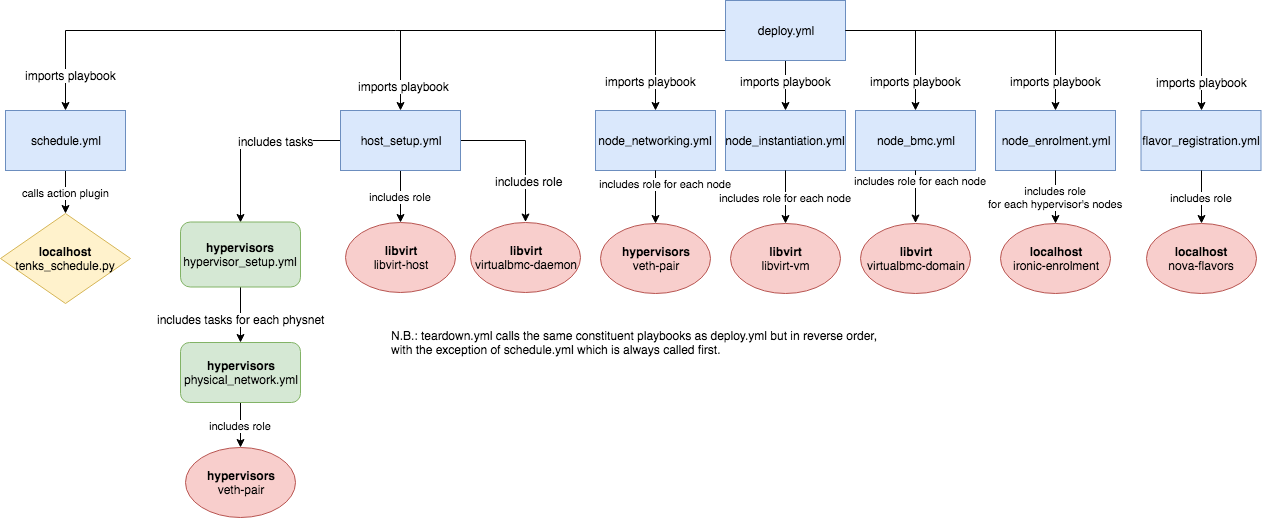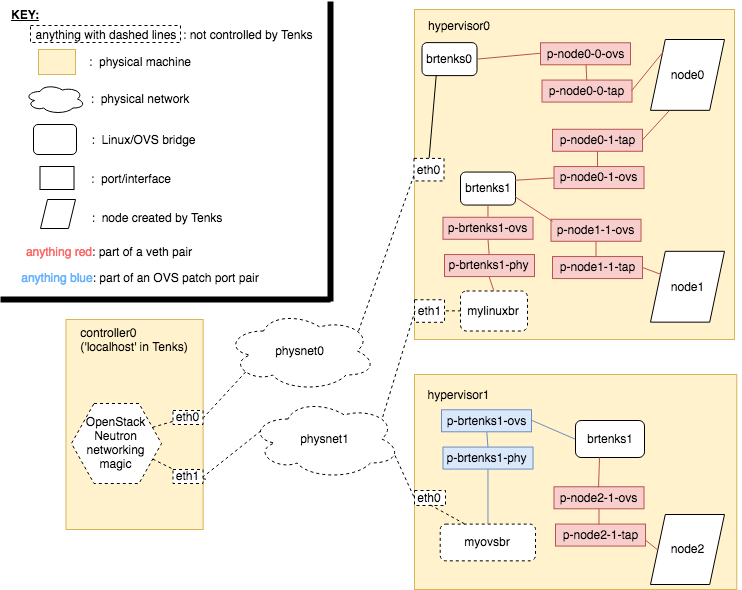For optimal reading, please switch to desktop mode.
Background
When I joined StackHPC for the summer, Mark gave me
a problem description. Testing OpenStack Ironic tends to be tough, due to the
difficulty of finding and provisioning bare metal hardware for the purpose. The
normal solution to this is to set up one or more virtual machines to act as
pseudo-bare metal servers to simulate a cluster. Automation of this task
already exists in Bifrost's test scripts, TripleO's
quickstart, Ironic's own DevStack script, and possibly
others too. However, none of these has become a de facto tool for virtual
cluster deployment, be it due to lack of extensibility, tight coupling with
their respective environment, or an architecture centred around monolithic
shell scripts.

...enter Tenks!
Tenks is a new tool designed to solve this problem.
 |
| Source: xkcd 927 |
Written mostly in Ansible with custom Python plugins where necessary, it is
designed to be a general virtual cluster orchestration utility. As well as
allowing a developer to spin up a test cluster with minimal configuration, Mark
explained that neither the Kolla nor the Kayobe project
performs testing of Ironic in any of its continuous integration jobs; this is
another key use case which Tenks should assist with.
Implementation
Key Features
After some discussion and drafting of an Ironic feature specification,
the scope was broken down into a few key components, and a set of desired
capabilities was created. Some of the features that have been implemented
include:
-
Multi-hypervisor support. While the commonest use case may well be
all-in-one deployment (when all cluster nodes are hosted on the same machine
from which Tenks is executed: localhost), it was deemed important for Tenks
to allow the use of multiple different hypervisors, each of which hosting a
subset of the cluster nodes (localhost optionally also performing this
role).
This feature was implemented almost "for free", thanks to Ansible's
multi-host nature. Different Ansible groups are defined to
represent the different roles within Tenks, and the user creates an inventory
file to add hosts to each group as they please.
-
Extensibility. Tenks was designed with a set of default assumptions.
These include the assumption that the user will want to employ the
Libvirt/QEMU/KVM stack to provide virtualisation on the hypervisors and
Virtual BMC to provide a virtual platform management interface using
IPMI; it is also assumed that the user will have provisioned the physical
network infrastructure between the hypervisors.
However, these assumptions do not impact the extensibility of Tenks. The
tool is written as a set of Ansible playbooks, each of which delegates
different tasks to different hosts. If, in future, there is a use case for
OpenStack to be added as a provider in place of the Libvirt stack (as the
sushy-tools emulator, for example, already allows), the
existing plays need not be modified. The new provider can be added as a
sub-group of the existing Ansible hypervisors group: any existing
Libvirt-specific tasks will automatically be omitted, and new tasks can be
added for the new group.
-
Tear-down and reconfiguration. Whether used as an ephemeral cluster for
a CI job or for a developer's test environment, a deployed Tenks cluster will
need to be cleaned up afterwards. A developer may also wish to reconfigure
their cluster to add or remove nodes, without affecting the existing nodes.
Tear-down was reasonably easy to implement due to the modular nature of
Tenks' tasks. To a large extent, tear-down involves running the deployment
playbooks "in reverse". The Ansible convention of having a state variable
with values present and absent means that minimal duplication of logic
was required to do this.
Reconfiguration required a little more thought, but this too was
implemented without too much disruption to the core playbooks. The
scheduling of nodes to hypervisors is performed by a custom Ansible action
plugin, which is where most of the reconfiguration logic lies. The state of
the existing cluster (if any) is preserved in a YAML file, and this is
compared to the cluster configuration that was given to Tenks. The
scheduling plugin decides which existing nodes should be purged, and how
many new nodes need to be provisioned. It eventually outputs an updated
cluster state which is saved in the YAML file, then the rest of Tenks runs
as normal from this configuration.
Architecture
The below diagram represents the interaction of the different Ansible
components within Tenks. The libvirt-vm and libvirt-host roles are imported
from StackHPC's Ansible Galaxy collection; the rest are internal to
Tenks.

Networking
To allow testing of a wider range of scenarios, we decided it was important
that Tenks support multihomed nodes. This would represent an improvement on the
capabilities of DevStack, by allowing an arbitrary number of networks to be
configured and connected to any node.
Tenks has a concept of 'physical network' which currently must map one-to-one
to the hardware networks plugged into the hypervisors. It requires device
mappings to be specified on a hypervisor for each physical network that is to
be connected to nodes on that hypervisor. This device can be an interface, a
Linux bridge or an Open vSwitch bridge. For each physical network that is given
a mapping on a hypervisor, a new Tenks-managed Open vSwitch bridge is created.
If the device mapped to this physnet is an interface, it is plugged directly
into the new bridge. If the device is an existing Linux bridge, a veth pair is
created to connect the existing bridge to the new bridge. If the device is an
existing Open vSwitch bridge, an Open vSwitch patch port is created to link the
two bridges.
A new veth pair is created for each physical network that each node on each
hypervisor is connected to, and one end of the pair is plugged into the Tenks
Open vSwitch bridge for that physical network; the other end will be plugged
into the node itself. Creation of these veth pairs is necessary (at least for
the Libvirt provider) to ensure that an interface is present in Open vSwitch
even when the node itself is powered off.
 |
| An example of the networking structure of Tenks. In this example, one node was requested to be connected to physnet0 and physnet1, and two nodes were requested to be connected just to physnet1. |
Desirable Extensions
There are many features and extensions to the functionality of Tenks that I
would make if I had more time at StackHPC. A few examples of these follow.
More Providers and Platform Management Systems
As mentioned earlier, it would be useful to extend Tenks to support providers
other than Libvirt/QEMU/KVM - for example, VirtualBox, VMware or OpenStack.
Redfish is also gaining momentum in the Ironic community as an alternative
to IPMI-over-LAN, so adding support for this to Tenks would widen its appeal.
Increased Networking Complexity
As described in the Networking section above, making the assumption that each
network to which nodes are connected will have a physical counterpart imposes
some limitations. For example, if a hypervisor has fewer interfaces than
physical networks exist in Tenks, either one or more physical networks will not
be usable by nodes on that hypervisor, or multiple networks will have to share
the same interface, breaking network isolation.
It would be useful for Tenks to support more complex software-defined
networking. This could allow multiple 'physical networks' to safely share the
same physical link on a hypervisor. VLAN tagging is used by certain OpenStack
networking drivers (networking-generic-switch, for example) to provide tenant
isolation for instance traffic. While this in itself is outside of the scope of
Tenks, it would need to be taken into account if VLANs were also used for
network separation in Tenks, due to potential gotchas when using nested VLANs.
More Intelligent Scheduling
The current system used to choose a hypervisor to host each node is rather
naïve: it uses a round-robin approach to cycle through the hypervisors. If
the next hypervisor in the cycle is not able to host the node, it will check
the others as well. However, the incorporation of more advanced scheduling
heuristics to inform more optimal placement of nodes would be desirable. All of
Ansible's gathered facts about each hypervisor are available to the scheduling
plugin, so it would be relatively straightforward to use facts about
total/available memory or CPU load to shift the load balance towards more
capable hypervisors.
Evaluation
Overall, I'm happy with the progress I've been able to make during my
internship. The rest of the team has been very welcoming and I've got a lot out
of the experience (special thanks to Mark for supervising and painstakingly
reviewing all my pull requests!). Roughly the first half of my time here was
spent reacquainting myself with OpenStack and the technologies around it, by
way of performing test OpenStack deployments with various configurations on a
virtual machine and preparing patches to be submitted upstream to fix issues as
I encountered them. While this process meant that I didn't spend my entire
internship working directly on Tenks, it was a very useful opportunity to 'dip
my toes' back into the OpenStack ecosystem and it helped to shape the design
decisions I made later on when developing Tenks.
Due to the time constraints of my placement, the initial work on Tenks was
started outside of the OpenStack ecosystem. It has been an enjoyable summer
project, but it would be more gratifying to see it continue in development and
use not only within the company, but hopefully with the OpenStack community as
an upstream project. Feel free to check out the project repository
and read the documentation about contribution if you'd like to get involved.
Finally, to my colleagues at StackHPC: so long and Tenks for all the fish!
Footnotes